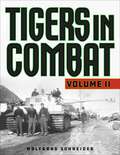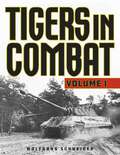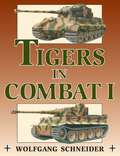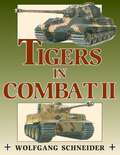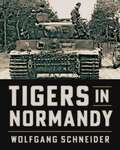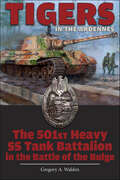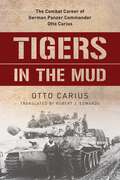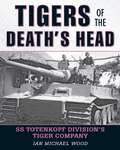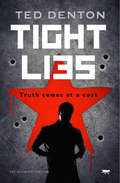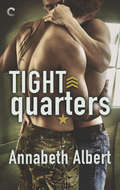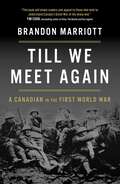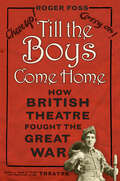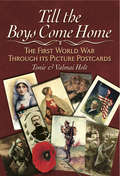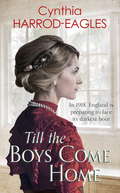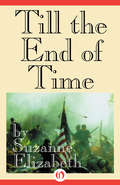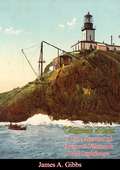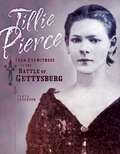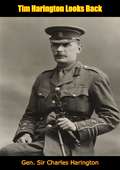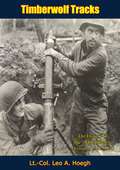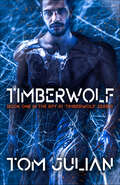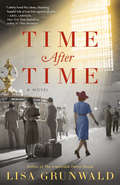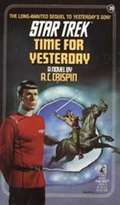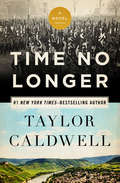- Table View
- List View
Tigers in Combat
by Wolfgang Schneider• Hundreds of photos--many of them rare--of Tiger tanks and their crews • Color illustrations by Jean Restayn focus on markings, camouflage, and insignia • Inventories and timelines for each unit In this follow-up to Tigers in Combat I (0-8117-3171-5), Wolfgang Schneider turns his attention to the Tiger tanks of the Waffen-SS and the Wehrmacht's "named" units, such as the Großdeutschland Division, Company Hummel, and Tiger Group Meyer. Based on combat diaries, the text tells the history of each unit, but most of the book is devoted to photos of the tanks and the men who manned them. It offers as unique and comprehensive a look at these lethal machines as is possible decades after World War II.
Tigers in Combat
by Wolfgang SchneiderScores of unique photos of Tiger tanks Intricate and richly colored drawings, with special focus on markings and insigniaAccompanying text lists units' combat strengths, equipment, commanders, and engagements By the end of World War II, the dreaded Tiger tank had achieved mythical, almost mystical status. In this much-sought-after volume on the Wehrmacht's numbered Tiger units, Wolfgang Schneider tells--in pictures--the story of these renowned tanks. Hundreds of photos depict Tigers in all situations and terrain, and a section of painstakingly detailed drawings brings the tanks to life in the metallic grays, snow whites, desert tans, and forest greens and browns that colored them. Modelers and buffs alike will delight in this impressive collection.
Tigers in Combat
by Wolfgang SchneiderScores of unique photos of Tiger tanks. Intricate and richly colored drawings, with special focus on markings and insignia. Accompanying text lists units' combat strengths, equipment, commanders, and engagements.
Tigers in Combat
by Wolfgang Schneider• Hundreds of photos--many of them rare--of Tiger tanks and their crews • Color illustrations by Jean Restayn focus on markings, camouflage, and insignia • Inventories and timelines for each unit In this follow-up to Tigers in Combat I (0-8117-3171-5), Wolfgang Schneider turns his attention to the Tiger tanks of the Waffen-SS and the Wehrmacht's "named" units, such as the Großdeutschland Division, Company Hummel, and Tiger Group Meyer. Based on combat diaries, the text tells the history of each unit, but most of the book is devoted to photos of the tanks and the men who manned them. It offers as unique and comprehensive a look at these lethal machines as is possible sixty years after World War II.
Tigers in Normandy
by Wolfgang SchneiderThis book has it all ... like reading an After the Battle and Panzerwrecks combined ... highly recommended! --Chuck Aleshire, AMPS Chicagoland
Tigers in the Ardennes: The 501st Heavy SS Tank Battalion in the Battle of the Bulge
by Gregory A. WaldenDetailed look at the German 501st SS Heavy Tank Battalion in the Battle of the Bulge
Tigers in the Mud: The Combat Career of German Panzer Commander Otto Carius
by Otto CariusWWII began with a metallic roar as the German Blitzkrieg raced across Europe, spearheaded by the most dreaded weapon of the 20th century: the Panzer. No German tank better represents that thundering power than the infamous Tiger, and Otto Carius was one of the most successful commanders to ever take a Tiger into battle, destroying well over 150 enemy tanks during his incredible career.
Tigers of the Death's Head
by Michael WoodDetailed history of the Tiger company of Nazi Germany's notorious "Death's Head" panzer division of the Waffen-SS.
Tight Lies: The Ultimate Thriller (The Tom Hunter Books #1)
by Ted DentonBehind the refined veneer of professional golf, a sports agent discovers a world of corruption and international criminals: “Hard, fast and really good!” —Lee ChildDaniel Ratchet has arrived in Spain, ready to begin his dream job as a golf agent on the professional Tour. Meanwhile, in London, new Tour sponsor Russian Rublex Corporation, with a hidden history of mafia criminality, is pushing through a huge deal with the British government. But things are not what they seem . . .With the help of Wallace, a cantankerous old golf coach, Daniel discovers match fixing, fraud, and corruption at the heart of the game. A thorn in the Russians’ side, Daniel is kidnapped before he can expose the truth. So Wallace contacts an old army buddy—who deploys loose cannon Tom Hunter on a mission to save him . . .This explosive debut novel is an exhilarating action thriller set in the seductive world of professional sports—against a backdrop of political and corporate corruption in a world of brutal violence.
Tight Quarters (Out of Uniform #6)
by Annabeth AlbertPetty Officer Bacon, a navy SEAL and ace sharpshooter, has been on the front lines of more than his fair share of dangerous ops. Yet when a minor injury relegates him to the beta team, he’s tasked with what may be his riskiest assignment yet: the silver fox journalist he’s babysitting is the hottest, most charismatic man he’s ever encountered.Award-winning journalist Spencer Bryant may have been named one of Pride magazine’s most eligible bachelors of the year, but he’s not looking to change his relationship status. He’s a consummate professional who won’t risk his ethics or impeccable reputation by getting involved with a source. Even a sexy-as-hell military man. But while Spencer can resist his physical attraction to Bacon, he has less control over his emotions—especially when the mission goes sideways and the two men are trapped alone.Getting out of the jungle alive turns out to be easy compared to facing the truth about their feelings for one another back in the real world. And whether or not they can build a future is a different story altogether.This book is approximately 82,000 wordsOne-click with confidence. This title is part of the Carina Press Romance Promise: all the romance you’re looking for with an HEA/HFN. It’s a promise!
Till We Meet Again: A Canadian in the First World War
by Brandon MarriottAn incredibly evocative and action-filled story of one man&’s fight in the First World War, rich and raw with remarkable detail.As he tended to the chores on his homestead, Lester Harper never imagined that he would turn in his hoe for a Lee-Enfield rifle on the Western Front. But the farmer from Pouce Coupe, in northern British Columbia, found himself at a party agreeing to help form a small-town regiment headed for France and the Great War. Lester left behind his wife, Mabel, in the shadow of the loss of their infant daughter, Hilda. A marksman before he even volunteered for the Canadian Army, Lester joined his cousin and friends, thousands of miles from his home, mere yards from the bayonets, bullets, and gas bombs of the feared Boche. In Till We Meet Again, the First World War comes to life in unprecedented detail, drawing on Lester&’s letters as well as meticulous historical research. Not since Timothy Findley&’s The Wars, Tim Cook&’s magisterial works about the First World War, or Erich Maria Remarque&’s All Quiet on the Western Front has a book about a soldier&’s life at the sharp end been told with such humour, gravitas, and in a heart-pounding narrative that drops you behind enemy lines. For at one point, Lester was trapped in a shell hole, a heartbeat away from the Germans setting up their machine gun to mow down his comrades. This is a remarkable story, remarkably told. This book will be heralded by historians as a new approach to telling a soldier&’s story and will become beloved by readers of military history and anyone who wants to understand what life was like for our boys behind the wire.
Till the Boys Come Home: How British Theatre Fought the Great War
by Roger FossEver since the signing of the Armistice in 1918, theatre has played an important part in reflecting the experience of the ‘war to end all wars’. But on the Home Front, what role did those involved with British theatre play during those tumultuous four years and three months? Till the Boys Come Home salutes British theatre in wartime, when theatres became powerful generators for escapism, for stirring patriotism, for sharing experiences of loss and joy – and for raising vast amounts of charity money. It brings to life a Britain where theatre-going peaked in popularity, yet became full of the curious contradictions bred by war. Richly illustrated with original programmes, posters and ephemera, author and critic Roger Foss reveals a theatrical powerhouse, where all sections of the profession – from grand Shakespearian knights to lowly concert party artistes – were doing their bit, both at home and on the front line.
Till the Boys Come Home: The First World War through its Picture Postcards
by Tonie Holt Valmai HoltThis is a new edition of this classic book which includes, in its over 700 postcards, many new, powerful propaganda images from nations on both sides of this epic conflict. Here are cards from the Queen's Collection, cards from America, Australia, Austria, Belgium, Britain, Bulgaria, Canada, Czechoslovakia, Egypt, France, Germany, Holland, Italy, Rumania, Salonika, Serbia... All are faithfully reproduced from the original, whether in dramatic black and white or in exuberant colour and they are all at least 100 years old. But this is not just a picture book.Here is a rich treasure trove to be dipped into for dilettante pleasure or to be read seriously as a thematic and contemporary history of the war. These cards have been collected over many years and a good number are rare and extremely valuable, both intrinsically and for the fascinating information contained in the informative running text and in the thoughtful captions (an example appears below, just one of the over 700). This is essential reading for anyone who wishes to sense the feelings and emotions of those who lived through, and fought in, the First World War; readers will appreciate the Twitter-like brevity of the captions, the power of the images and enjoy the chase to understand what lies behind them.This handsome and fascinating book uses hundreds of the immensely popular picture postcards of the '14-'18 period to document the course and effects of the Great War, with all its dramatis personae, its humour, suffering, patriotism, sentimentality and fervour.
Till the Boys Come Home: War at Home 5 (War At Home Ser.)
by Cynthia Harrod-EaglesIn 1918 the Great War has taken so much from so many and it threatens to take even more still from the Hunters, their friends and their servants.Edward, in a bid to run away from problems at home, decides not to resist conscription and ends up at the Front. Sadie's hopes for love are unrequited, and Laura has to flee Artemis House when it is shelled and she finds herself in London driving an ambulance. Ethel, the nursery maid, masks her own pain by caring for other people's children but she must take care not to get too attached.The government has to bring in rationing, and manpower shortages means the conscription age is extended. The Russians have fallen out of the war and a series of terrifying all-out attacks drive the Allies back almost to the Channel, and for the first time England faces the real prospect of defeat. No one can see an end to the war and yet, a small glimmer of hope remains . . .When the Boys Come Home is the fifth book in the War at Home series by Cynthia Harrod-Eagles, author of the much-loved Morland Dynasty novels. Set against the real events of 1918, at home and on the front, this is a vivid and rich family drama featuring the Hunter family and their servants.
Till the Boys Come Home: War at Home, 1918 (War at Home #5)
by Cynthia Harrod-EaglesThe final book in Cynthia's War at Home series - Pack Up Your Troubles - is available to pre-order now.'Always a stay-up-all-night read with Cynthia Harrod-Eagles! *****'Fabulous series of books, this author never disappoints' *****'I love Cynthia Harrold-Eagles' historical novels' *****In 1918 the Great War has taken so much from so many and it threatens to take even more still from the Hunters, their friends and their servants.Edward, in a bid to run away from problems at home, decides not to resist conscription and ends up at the Front. Sadie's hopes for love are unrequited, and Laura has to flee Artemis House when it is shelled and she finds herself in London driving an ambulance. Ethel, the nursery maid, masks her own pain by caring for other people's children but she must take care not to get too attached.The government has to bring in rationing, and manpower shortages means the conscription age is extended. The Russians have fallen out of the war and a series of terrifying all-out attacks drive the Allies back almost to the Channel, and for the first time England faces the real prospect of defeat. No one can see an end to the war and yet, a small glimmer of hope remains . . .When the Boys Come Home is the fifth book in the War at Home series by Cynthia Harrod-Eagles, author of the much-loved Morland Dynasty novels. Set against the real events of 1918, at home and on the front, this is a vivid and rich family drama featuring the Hunter family and their servants.
Till the Boys Come Home: War at Home, 1918 (War at Home #5)
by Cynthia Harrod-EaglesIn 1918 the Great War has taken so much from so many and it threatens to take even more still from the Hunters, their friends and their servants.Edward, in a bid to run away from problems at home, decides not to resist conscription and ends up at the Front. Sadie's hopes for love are unrequited, and Laura has to flee Artemis House when it is shelled and she finds herself in London driving an ambulance. Ethel, the nursery maid, masks her own pain by caring for other people's children but she must take care not to get too attached.The government has to bring in rationing, and manpower shortages means the conscription age is extended. The Russians have fallen out of the war and a series of terrifying all-out attacks drive the Allies back almost to the Channel, and for the first time England faces the real prospect of defeat. No one can see an end to the war and yet, a small glimmer of hope remains . . .When the Boys Come Home is the fifth book in the War at Home series by Cynthia Harrod-Eagles, author of the much-loved Morland Dynasty novels. Set against the real events of 1918, at home and on the front, this is a vivid and rich family drama featuring the Hunter family and their servants.
Till the End of Time
by Suzanne ElizabethTwentieth century test pilot Captain Scott Ramsey is unwillingly trapped in the middle of the Civil War. Disguised as a rebel pirate, his art of seduction and mastery of disguise soon earn him a scandalous reputation. For her first assignment as a Union spy, Rachel Ann Warren must ensure that a hefty fortune remains safely out of the mysterious pirate's hands. The lovely undercover agent instantly intrigues Captain Ramsey. She possesses a strength and cunning that he has never witnessed, even in the women from his own time. He is overcome by his desire to return to his secure life in the future, but he can't seem to get the vision of Rachel out of his mind. As their passion grows, so do the emotions of the war around them. Beneath the fire of angry bullets, the star-crossed lovers melt the barriers of loyalty and time.
Tillamook Light: A True Account of Oregon’s Tillamook Rock Lighthouse
by James A. GibbsThe lighthouse keeper has gone the way of the iceman and blacksmith, but in the case of Tillamook Rock Lighthouse, the story remains--a complete history of "Terrible Tilly," seasoned with salty drama and some hilarious adventure. Gibbs, a former Coastguardsman stationed at the infamous rock off Oregon's north-west shores, knows that wild crag from the inside out, and he has supplemented his account with what happened before he arrived on the scene, and since closure of the light in 1957.Since 1881, Tillamook Rock Lighthouse had been a major factor in marine navigation, from commercial sailing-vessel days down to the age of nuclear-propelled ships. Rightfully famous, the rock has rarely been visited because of its inaccessibility, but countless thousands have gazed at this awesome monolith from shore-side, or shipboard, especially during stormy weather when breakers beat unmercifully against its encrusted crags, and a raging, roiling sea appears determined to break the rock in half....Of all the lighthouses that dot the shores of the world, few can match the heroic setting of Tillamook Rock, or the turbulent and colorful history of its lighthouse.
Tillie Pierce: Teen Eyewitness to the Battle of Gettysburg
by Tanya AndersonImagine being fifteen years old, facing the bloodiest battle ever to take place on U.S. soil: the Battle of Gettysburg. In July 1863, this is exactly what happened to Tillie Pierce, a normal teenager who became an unlikely heroine of the Civil War (1861-1865). Tillie and other women and girls like her found themselves trapped during this critical three-day battle in southern Pennsylvania. Without training, but with enormous courage and compassion, Tillie and other Gettysburg citizens helped save the lives of countless wounded Union and Confederate soldiers. In gripping prose, Tillie Pierce: Teen Eyewitness to the of Battle Gettysburg takes readers behind the scenes. And through Tillie’s own words, the story of one of the Civil War’s most famous battles comes alive.
Tim Harington Looks Back
by Gen. Sir Charles HaringtonGeneral Sir Charles Harington Harington, who received the nickname “Tim” after being gazetted to The King’s Regiment and joining the Serapis at Aden in 1892, was a British Army officer who served in the Directorate of Mobilization in 1914 and then became Plumer's BGGS in the 2nd Army in France. After World War I, he became DCIGS to Henry Wilson, then GOC Allied Forces of Occupation in Constantinople during the Chanak Affair, which partly led to the downfall of Lloyd George's administration.It was in October 1920 that Harington was sent by Mr. Winston Churchill—then Secretary of State for War—to Constantinople to succeed General (later Field-Marshal Lord) Milne. The Force at Constantinople (28th Division) was to be reduced to six battalions, a cavalry regiment and some gunners, and Harington was to see the treaty ratified. He was also to lead a Greek division at Ismid, and a Greek regiment at Beicos opposite Therapia on the Bosphorus.Tim Harington Looks Back is his very own full and frank account of his fascinating life—from his early beginnings, to his military career, to being received by His Majesty the King.
Timberwolf Tracks: The History of the 104th Infantry Division, 1942-1945
by Lt.-Col. Leo A. Hoegh“‘The most rigorous service which a soldier is called upon to perform is the duty of a ground combat soldier. He is the man who must wade in the mud, endure heat and cold, and sleep on the ground. That is the toughest kind of service.’ These words, spoken from the floor of the United States Senate on April 19th, 1945 reflect the sincere feeling of the American people toward the Queen of Battles.“Through the medium of TIMBERWOLF TRACKS, it is our intention to present an honest commentary on the fighting in Europe incurred by the U.S. Infantryman...specifically the ground combat soldier who wore the green and silver patch of the Timberwolf. His lot was not a glamorous one; he fought, ate, slept in mud, snow and hail; his battle-weary body answered the call to move up time and time again while his tortured mind heroically withstood the numbing shock of having time-honored buddies fall by the wayside. His moments of praise were fleeting and none too consoling—still he wore the blue and silver Combat Infantryman Badge with an intense burning pride and he gloried in the record and achievements of his ‘outfit.’ His was the supreme satisfaction of a job well done.“The 104th Infantry Division did not win the war. We make no such far-reaching claim...but the Timberwolves did play a most effective role in crushing the iron fist of Nazidom. The record, compiled by the men of this fighting division, is in the words of the Commanding General ‘second to none’. It is appropriate that such a record be preserved. In the following pages, Americans may find a justifiable gratefulness that such men as these stood so valorously between them and slavery.”
Timberwolf: Book One In The Spy-fi 'timberwolf' Series (The Spy-fi 'Timberwolf' Series)
by Tom JulianOnce a top black ops agent, Timberwolf Velez's world shatters when he encounters Kizik, a malevolent psychic alien spider that leaves a lasting mark on his psyche. Haunted by his past, Timberwolf now faces an ominous threat as a religious fanatic unearths a hidden cache of unimaginably destructive weapons. Will Timberwolf rise above his shattered mind and prevent the galaxy from descending into irreversible chaos? With an ensemble of captivating characters and exhilarating twists at every turn, TIMBERWOLF: Book One in the Spy-Fi ‘Timberwolf’ Series will keep you on the edge of your seat. Brace yourself for a heart-pounding, action-packed page-turner that refuses to release its grip.
Time After Time: A Novel
by Lisa GrunwaldA magical love story, inspired by the legend of a woman who vanished from Grand Central Terminal, sweeps readers from the 1920s to World War II and beyond. “Readers who enjoyed The Time Traveler’s Wife will be enchanted.”—Publishers Weekly“I utterly loved this clever, charming, hopeful tale of true love against all odds.”—Ariel Lawhon, New York Times bestselling author of I Was Anastasia On a clear December morning in 1937, at the famous gold clock in Grand Central Terminal, Joe Reynolds, a hardworking railroad man from Queens, meets a vibrant young woman who seems mysteriously out of place. Nora Lansing is a Manhattan socialite whose flapper clothing, pearl earrings, and talk of the Roaring Twenties don’t seem to match the bleak mood of Depression-era New York. Captivated by Nora from her first electric touch, Joe despairs when he tries to walk her home and she disappears. Finding her again—and again—will become the focus of his love and his life. Nora, a fiercely independent aspiring artist, is shocked to find she’s somehow been trapped, her presence in the terminal governed by rules she cannot fathom. It isn’t until she meets Joe that she begins to understand the effect that time is having on her, and the possible connections to the workings of Grand Central and the solar phenomenon known as Manhattanhenge, when the sun rises or sets between the city’s skyscrapers, aligned perfectly with the streets below. As thousands of visitors pass under the famous celestial blue ceiling each day, Joe and Nora create a life unlike any they could have imagined. With infinite love in a finite space, they take full advantage of the “Terminal City” within a city, dining at the Oyster Bar, visiting the Whispering Gallery, and making a home at the Biltmore Hotel. But when the construction of another landmark threatens their future, Nora and Joe are forced to test the limits of freedom and love.Delving into Grand Central Terminal’s rich past, Lisa Grunwald crafts a masterful historical novel about a love affair that defies age, class, place, and even time.Advance praise for Time After Time “I’ll never again set foot in Grand Central Terminal without looking over my shoulder for Nora and Joe, or marveling at the station itself—a backdrop as intriguing as the love story that unfolds beneath its star-studded ceiling.”—Georgia Hunter, New York Times bestselling author of We Were the Lucky Ones “Time After Time doesn’t just re-create the lost New York of the 1920s to 1940s, it inhabits it—and so will the reader, in the company of the book’s wonderful characters.”—Daniel Okrent, author of Last Call and The Guarded Gate
Time For Yesterday (Star Trek: The Original Series #39)
by A.C. CrispinTime For Yesterday Time in the galaxy has stopped running its normal course. That can only mean one thing -- the Guardian of Forever is malfunctioning. To save the universe, Starfleet command reunites three of its most legendary figures -- Admiral James T. Kirk, Spock of Vulcan, and Dr. Leonard McCoy -- and sends them on a desperate mission to contact the Guardian, a journey that ultimately takes them 5,000 years into the past. They must find Spock's son Zar once again -- and bring him back to their time to telepathically communicate the Guardian. But Zar is enmeshed in troubles of his own, and soon Kirk, Spock and McCoy find themselves in a desperate struggle to save both their world -- and his!
Time No Longer: A Novel
by Taylor CaldwellOn the eve of World War II, twin brothers are divided by the murder of a German Jew, in this epic tale from New York Times–bestselling author Taylor Caldwell. Karl Erlich loves his country. But these are dangerous times for Germany, whose poor and downtrodden have been seduced by an Austrian sign painter named Adolf Hitler. Karl&’s twin brother, Kurt, a distinguished scientist, has already pledged his allegiance to the Third Reich, a regime that Karl finds cruel and oppressive. But he soon has even more reason to fear: There is talk of the Nazis singling out the Jews for extermination. Karl and Kurt&’s younger sister, Gerda, is engaged to Eric Rheinhardt, a German Jew. Before Gerda and Eric can escape to America, Eric is arrested by the Gestapo. Then the unthinkable happens, and in the wake of searing tragedy, Karl cuts all ties with his brother. A onetime candidate for the Nobel Prize for Literature, he is no longer able to write, eat, or sleep. His wife, Therese, fears for his sanity. She knows she must get her husband away from the madness that is now Germany. But can she rescue her husband, who is rapidly becoming like their beleaguered Rhineland—inconsolable, frightened, and thirsting for revenge? As she seeks answers, unknowingly thrusting herself into harm&’s way, Therese will discover the powerful ties that bind German to Jew, and come to realize that the only one way to save Karl is to save Germany. Set in the years of the Nazis&’ ascent to power, Time No Longer is at once a universal and intensely personal novel about the struggle against hate and fear that can elevate an ordinary man to extraordinary heights and the unassailable bond between two brothers.
